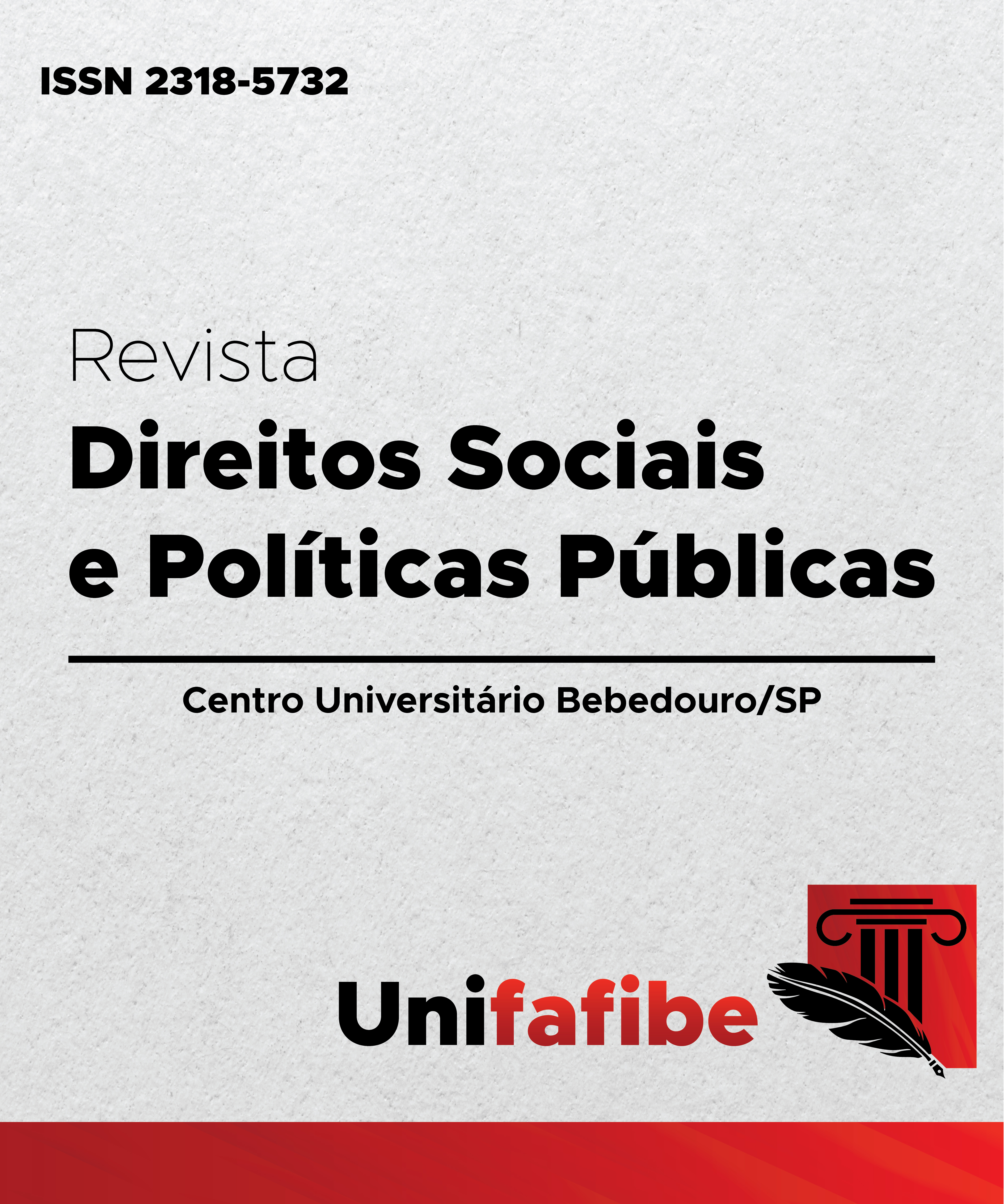ATROCITIES WITH A POSITIVE ACCOUNT BALANCE? INCLUDING MEASURES TO RECAPTURE CORPORATE PROFITS DERIVED FROM GROSS HUMAN RIGHTS VIOLATIONS IN REPARATION PROGRAMMES UNDER THE INTERNATIONAL LEGAL FRAMEWORK OF STATE RESPONSIBILITY
DOI:
https://doi.org/10.25245/rdspp.v10i1.1222Palavras-chave:
reparation, state responsibility, internationally wrongful acts, human rights, business actorsResumo
Although steps are being made to make companies participate in the redress of the human rights violations they have committed, at the current level of development of international law the obligation to make reparation continues to reside with the States. Indeed, certain legal norms and principles in the general regime of responsibility of the State for internationally wrongful acts would justify – or even require – the adoption of measures to restore the profits obtained by companies as a result of their involvement in the commission of serious violations of human rights. The implementation of such ‘profit recapture measures’ could be better done through large-scale administrative reparation programmes that give effect to the State obligation to redress victims.Referências
See, for example, Stefano Manacorda, ‘Towards an Anti-Bribery Compliance Model: Methods and Strategies for a “Hybrid Normativity”’ in Stefano Manacorda, Francesco Centone and Gabrio Forti (eds), Preventing Corporate Corruption. The Anti-Bribery Compliance Model (Springer 2014) 16-17; Leigh A Payne and Gabriel Pereira, ‘Corporate complicity in international human rights violations’ (2016) 12 Annu Rev Law Soc Sci. 63, 64-66.
On the interlinkage between transitional justice and peacebuilding, see Catherine Baker and Jelena Obradovic-Wochnik, ‘Mapping the Nexus of Transitional Justice and Peacebuilding’ (2016) 10 J Interv Statebuilding 281.
See, for example, Louise Arbour, ‘Economic and social justice for societies in transition’ (2007) 40 JILP 1, 26-27; United Nations High Commissioner for Human Rights (UNHCHR) ‘Annual Report of the United Nations High Commissioner for Human Rights and Reports of the Office of the High Commissioner and the Secretary General: Analytical study on human rights and transitional justice’ (6 August 2009) UN Doc A/HRC/12/18 para 3; Gaby Oré Aguilar and Felipe Gómez Isa (eds), Rethinking Transitions. Equality and Social Justice in Societies Emerging from Conflict (Intersentia 2011); Paul Gready and Simon Robins, ‘From Transitional to Transformative Justice: A New Agenda for Practitioners’ (2014) 8 IJTJ 339; Francesca Capone, ‘A Reflection on the Transformative Potential of Reparations. The Approach of the Regional Human Rights Courts’ (2018) 12 HR&ILD 190. This perspective, however, is not exempt from criticism. Padraig McAuliffe considers that ‘critical transitional justice theorists have failed to make visible the political framework within which their aspirations for transformation are to be realized, to say nothing of the manner in which this framework sets opposition in motion to radical reform of economic structures.’ Padraig McAuliffe, Transformative Transitional Justice and the Malleability of Post-Conflict States (Edward Elgar Publishing 2017) 289. See also Kora Andrieu, ‘Dealing with a “New” Grievance: Should Anticorruption Be Part of the Transitional Justice Agenda?’(2012) 11 J Hum Rts 537, 553-54; Margaret Urban Walker, ‘Transformative Reparations? A Critical Look at a Current Trend in Thinking about Gender-Just Reparations’ (2016) 10 IJTJ 108. An intermediate stance is defended by Moffett, who suggests that the transformative potential should lie in guarantees of non-recurrence, rather than in reparation. Luke Moffett, ‘Reparations in Transitional Justice: Justice or Political Compromise?’ (2017) 11 HR&ILD 59.
See UNCHR ‘Report of the Independent Expert to Update the Set of Principles to Combat Impunity’ (2005) UN Doc E/CN.4/2005/102/Add.1.
Philipp Wesche, ‘Business actors and land restitution in the Colombian transition from armed conflict’ (2021) 25 Intl J Hum Rts 295, 295.
Most of the proceedings against business actors for extra-territorial human rights violations are civil, although the criminal path is also been explored in some States, such as The Netherlands (e.g., the complaint against Lima Holding B V, Riwal’s parent company, for involvement in war crimes, given its participation in the construction of the wall on occupied Palestinian territory – dismissed in 2013); Switzerland (e.g., complaints against Argor-Heraeus SA, for abetting the war in Democratic Republic of Congo through money laundering - case closed in 2015 -, or Nestlé, for its involvement in the murder of Colombian trade unionist Luciano Romero – dismissal confirmed in 2014), or France (e.g., complainst against Amesys – charged in June 2021 with complicity in acts of torture in Lybia; Qosmos, for complicity in human rights abuses by the Syrian government by providing it with surveillance technologies; or Lafarge, for complicity in crimes against humanity in Syria’s civil war – dismissal decision overturned in September 2021 by the Court of Cassation).
See Leigh A. Payne, ‘Truth commissions and corporate complicity’ in Joris van de Sandt and Marianne Moor (eds), Peace, Everybody’s Business! A Comparative Analysis of Corporate Accountability in Transitional Justice: Lessons for Colombia (Pax 2017).
Clara Sandoval, Leonardo Filippini and Roberto Vidal, ‘Linking Transitional Justice and Corporate Accountability’ in Sabine Michalowski (ed), Corporate Accountability in the Context of Transitional Justice (Routledge 2013), 18.
Although reparation would be indeed the classic way in international law to ‘wipe out all the consequences of the illegal act and re-establish the situation which would, in all probability, have existed if that act had not been committed.’ Case Concerning the Factory at Chorzów (Germany v Poland) (Merits) PCIJ Rep Series A No 17, 47.
See, for example, Clara Sandoval and Gill Surfleet, ‘Corporations and Redress in Transitional Justice Processes,’ in Michalowski (n 9); Tara L Van Ho, ‘Is it Already Too Late for Colombia’s Land Restitution Process? The Impact of International Investment Law on Transitional Justice Initiatives’ (2016) 5 Intl Hum Rts L Rev 60; Moffett (n 4); Irene Pietropaoli, ‘Remedy for corporate human rights abuses in transitional justice contexts’ (PhD thesis, Middlesex University 2017) <https://eprints.mdx.ac.uk/24310/1/IPietropaoli%20thesis.pdf> accessed 23 October 2021; Wesche (n 6).
Heidy Rombouts, Pietro Sardaro and Stef Vandeginste, ‘The Right to Reparation for Victims of Gross and Systematic Human Rights Violations,’ in K De Feyter, S Parmentier, M Bossuyt and P Lemmens (eds), Out of the Ashes. Reparation for Victims of Gross and Systematic Human Rights Violations (Intersentia 2005) 486 para. 201-02.
See Nien-he Hsieh, ‘Should Business Have Human Rights Obligations?’ (2015) 14 J Hum Rts 218.
Such as the ambitious one set out in Colombia. See Van Ho (n 12); Wesche (n 6). On land restitution within administrative reparation programmes see Pietropaoli (n 12) 184-201.
UNGA Res 56/83 (12 December 2001) UN Doc A/RES/56/83 Annex.
Basic Principles and Guidelines on the Right to a Remedy and Reparation for Victims of Gross Violations of International Human Rights Law and Serious Violations of International Humanitarian Law, UNGA Res 60/147 (16 December 2005) UN Doc A/RES/60/147.
Art 30 a) ARSIWA.
Art 30 b) ARSIWA.
Art 31.1 ARSIWA. Such injury includes ‘any damage, whether material or moral, caused by the internationally wrongful act of a State’ (art 31.2 ARSIWA).
Including the payment of interests ‘on any principal sum due under this chapter … when necessary in order to ensure full reparation’ (art 38 ARSIWA) but excluding interest on the profit earning-capital over the same period of time. ILC, ‘Responsibility of States for Internationally Wrongful Acts’ [2001] II 2 YbILC 105 [33] (Commentary to Draft Article 36).
Art 34 ARSIWA.
ILC (n 21) 106 [5] (Commentary to Draft Article 37).
Without this implying that all the norms of international humanitarian law and/or international criminal law have that objective.
See International Covenant on Civil and Political Rights (adopted 16 December 1966, entered into force 23 March 1976) 999 UNTS 171 art 2.3; Convention for the Protection of Human Rights and Fundamental Freedoms (European Convention on Human Rights, as amended) art 13; American Convention on Human Rights (adopted 22 November 1969, entered into force 18 July 1978) 1144 UNTS 123 art 25; revised Arab Charter on Human Rights (adopted 22 May 2004, entered into force 15 March 2008) English translation in UN Doc CHR/NONE/2004/40/Rev.1 art 12- including the right to seek judicial remedy, though it does not require that it be effective; art 8 also expressly states that each State party shall guarantee in its legal system redress for any victim of torture and the right to rehabilitation and compensation. On the contrary, it is not included in the African Charter on Human and Peoples’ Rights (adopted 27 June 1981, entered into force 21 October 1986) 1520 UNTS 217. The right of victims to a remedy appears in other human rights instruments, including the Universal Declaration of Human Rights (adopted 10 December 1948 UNGA Res 217 A(III) art 8; International Convention on the Elimination of All Forms of Racial Discrimination (adopted 21 December 1965, entered into force 4 January 1969) 660 UNTS 195 art 6; Convention Against Torture and Other Cruel, Inhuman or Degrading Treatment of Punishment (adopted 10 December 1984, entered into force 26 June 1987) 1465 UNTS 85 art 14; Convention on the Rights of the Child (adopted 20 November 1989, entered into force 2 September 1990) 1577 UNTS 3 art 39; International Convention for the Protection of All Persons from Enforced Disappearance (adopted 20 December 2006, entered into force 23 December 2010) 2716 UNTS 3 art 8. It also appears in instruments of international humanitarian law, including The Hague Convention (IV) respecting the laws and customs of war on land (Second International Peace Conference, adopted 18 October 1907, entered into force 26 January 1910) art 3; Protocol Additional to the Geneva Conventions of 12 August 1949, and relating to the protection of victims of international armed conflicts (Protocol I) (adopted 8 June 1977, entered into force 7 December 1978) 1125 UNTS 3 art 91. In relation to the reparation of victims, see also Rome Statute of the International Criminal Court (‘ICC’) (adopted 17 July 1998, entered into force 1 July 2002) 2187 UNTS 3 art 75.
Dinah Shelton, ‘The United Nations Principles and Guidelines on Reparations: Context and Contents’ in De Feyter et al (n 13) 13.
UN HRC ‘General Comment No 31’ (26 May 2004) UN Doc CCPR/C/21/Rev.1/Add.13 para 16.
Theo Van Boven, ‘The United Nations Basic Principles and Guidelines on the Right to a Remedy and Reparation for Victims of Gross Violations of International Human Rights Law and Serious Violations of International Humanitarian Law’ (United Nations Audiovisual Library of International Law, United Nations 2010) 1-2 <http://legal.un.org/avl/pdf/ha/ga_60-147/ga_60-147_e.pdf> accessed 23 October 2021.
UNHRC ‘Report of the Special Rapporteur on the promotion of truth, justice, reparation and guarantees of non-recurrence’ (14 October 2014) UN Doc A/69/518 para 18. It must be pointed out that the resolution was adopted by consensus.
Principle 15.
Principle 18. See also UN Doc A/69/518 (n 29) para 17.
Restitution (Principle 19) should, whenever possible, restore the victim to the original situation before the gross violations of international human rights law or serious violations of international humanitarian law occurred.
Compensation (Principle 20) should be provided for any economically assessable damage, as appropriate and proportional to the gravity of the violation and the circumstances of each case, resulting from gross violations of international human rights law and serious violations of international humanitarian law.
Rehabilitation (Principle 21) should include medical and psychological care as well as legal and social services.
Satisfaction (Principle 22) is a form of moral reparation (such as public apology, including acknowledgement of the facts and acceptance of responsibility, commemorations and tributes to the victims, etc.).
Guarantees of non-repetition (Principle 23) are structural measures that seek prevention (e.g., reviewing and reforming laws contributing to or allowing gross violations of international human rights law and serious violations of international humanitarian law).
Van Boven (n 26) 3. See also ‘Report of the second consultative meeting on the Basic principles and guidelines on the right to a remedy and reparation for victims of violations of international human rights and humanitarian law (Geneva, 20, 21 and 23 October 2003)’ in UNCHR ‘The right to a remedy and reparation for victims of violations of international human rights and humanitarian law. Note by the High Commissioner for Human Rights’ (10 November 2003) UN Doc E/CN.4/2004/57 28 (explanatory comment 4). Sandoval and Surfleet argue that Principle 15 ‘recognizes the obligation of entities other than states to provide reparations for victims of violations’ and support their claim by referring to the provisions of the right to reparations under the Rome Statute. Sandoval and Surfleet (n 11) 96.
See UN Doc E/CN.4/2004/57 (n 37) 27 (explanatory comment 4). The report specifically focuses on ‘groups referred to as non-State actors [that] have transformed themselves into the Governments of States by assuming power’ and ‘groups that assume effective control over certain territory and exercise over that territory and the people on that territory the equivalent control exercised by States’. No other non-state actors are mentioned.
Ellen Desmet, ‘The UN Basic Principles and Guidelines on the Right to a Remedy and Reparation: A Landmark or Window-Dressing: An Analysis with Special Attention to the Situation of Indigenous Peoples’ (2008) 24 South African Journal on Human Rights 71, 81.
Without wishing to examine this question in any great depth here, as it lies outside the scope of the present analysis, we should point out the difficulty of reconciling the criminal responsibility of companies in the current system of international criminal justice – understood as that system integrated by the domestic courts as primary jurisdictions over the core international crimes and the ICC as a complementary jurisdiction and the keystone to such system. Not all States include in their legal systems the criminal responsibility of legal persons for gross violations of human rights, neither does the Rome Statute of the ICC, which, consequently, cannot exercise its complementary jurisdiction in the case of crimes directly attributable to companies. On reparations in international criminal law see, for example, Emanuela-Chiara Gillard, ‘Reparation for violations of international humanitarian law’ (2003) 85 IRRC 529, 545-548; Christine Evans, The Right to Reparation in International Law for Victims of Armed Conflict (Cambridge University Press 2012) 86-124.
On the complexities surrounding responsibility of armed non-state actors, including reparations, see Laura Íñigo Álvarez, Towards a Regime of Responsibility of Armed Groups in International Law (Intersentia 2020).
See ILC (n 21) 38 [4] (Commentary to Chapter II).
Here, the UN HRC has indicated that ‘the positive obligations on States Parties to ensure Covenant rights will only be fully discharged if individuals are protected by the State, not just against violations of Covenant rights by its agents, but also against acts committed by private persons or entities that would impair the enjoyment of Covenant rights in so far as they are amenable to application between private persons or entities.’ UNHRC (n 26) para 8.
See in this regard Principle on Reparation 17.
Evans (n 40) 86.
See other precedents established outside these bodies in David Weissbrodt and Muria Kruger, ‘Norms on the Responsibilities of Transnational Corporations and Other Business Enterprises with Regard to Human Rights’ (2003) 97 AJIL 901, 902-03.
UNCHR Sub-Commission ‘Norms on the Responsibilities of Transnational Corporations and Other Business Enterprises with Regard to Human Rights’ (26 August 2003) UN Doc E/CN.4/Sub.2/2003/12/Rev.2 para 18.
ibid para. 19.
Weissbrodt and Kruger (n 48) 903.
UNCHR ‘Responsibilities of transnational corporations and related business enterprises with regard to human rights’ (20 April 2004) UN Doc E/CN.4/DEC/2004/116.
UNHRC ‘Report of the Special Representative of the Secretary-General on the issue of human rights and transnational corporations and other business enterprises, John Ruggie. Guiding Principles on Business and Human Rights: Implementing the United Nations “Protect, Respect and Remedy” Framework’ (21 March 2011) UN Doc A/HRC/17/31.
ibid 20 (Guiding Principle 22).
Mariëtte van Huijstee, Victor Ricco and Laura Ceresna-Chaturvedi, How to use the UN Guiding Principles on Business and Human Rights in company research and advocacy. A guide for civil society organisations (SOMO/CEDHA/Cividep India 2012) 12 <https://corporatejustice.org/how-to-use-the-un-guiding-principles-on-business-and-human-rights-in-company-research-and-advocacy.pdf> accessed 23 October 2021.
Guiding Principles 28 to 30.
UN Doc A/HRC/17/31 (n 53) 24 (Commentary to Guiding Principle 28).
Guiding Principle 28.
ibid 25 (Guiding Principle 29). See also Guiding Principle 30.
ibid (Commentary to Guiding Principle 29).
In fact, Ruggie admits that, when these mechanisms have dealt with human rights violations by companies, it has been in the context of cases of non-compliance with the State’s obligation to protect. ibid (commentary to Guiding Principle 28).
UNHRC ‘Report of the Working Group on the issue of human rights and transnational corporations and other business enterprises’ (18 July 2017) UN Doc A/72/162 (‘WG Report’).
ibid paras 14, 61.
ibid para 14.
ibid para 15.
See ibid paras 65–71.
ibid para 38.
ibid para 40.
ibid para 39.
ibid paras 42–53.
ibid para 54. The two do not a priori seem to be incompatible, but the examples provided (an injunction if there is prima facie evidence of possible damages or the possibility of seeking an order requiring a business enterprise to conduct a meaningful consultation with the affected community or conduct proper human rights due diligence) do not adequately demonstrate their interrelation and, more specifically, they do not make clear the reparative nature of these measures.
UN Open-ended intergovernmental working group on transnational corporations and other business enterprises with respect to human rights ‘Third Revised Draft Legally Binding Instrument to Regulate, in International Human Rights Law, the Activities of Transnational Corporations and Other Business Enterprises’ (17 August 2021) <https://www.ohchr.org/Documents/HRBodies/HRCouncil/WGTransCorp/Session6/LBI3rdDRAFT.pdf> accessed 23 October 2021.
See, for example, the general statement by Argentina on potential duplication of norms in UNGA ‘Report on the sixth session of the open-ended intergovernmental working group on transnational corporations and other business enterprises with respect to human rights’ (14 January 2021) UN Doc A/HRC/46/73 Annex, 3; Brasil (on avoiding ‘putting excessive burden upon states’) in ibid 5 [9]; the African Group (‘the draft should stick to the regulation of the activities of TNC’s and OBE’s, with respect to human rights, instead of placing many obligations to states …. Ultimately, the draft should seek to fill the existing gap in the international law in regards to the human rights abuses and violations by TNC’s and provide reparations and remedies to the victims’) in ibid 6; Chile (asking for a realistic proposal in terms of standards and commitments for States, as well as attention to its challenges to domestic law) in ibid 7 [7].
UN Doc A/69/518 (n 29) para 4. See also Sandoval and Surfleet (n 11) 108.
In fact, it would also be possible for such subsidiary reparation to be resolved by some other formula based on international cooperation and/or voluntary contributions, such as victims’ funds (e.g., the UN Voluntary Fund for Victims of Torture and the International Criminal Court’s Trust Fund for Victims). Special trust funds are one of the two models of State practice for dealing with the financing of reparations. The other option is the allocation of a dedicated budget line for this purpose. This second model has been the most effective to date (Segovia, supra n 12 at 660).
The lack of political will is a stronger determinant than socio-economic factors. UN Doc A/69/518 (n 29) paras 13 and 53; Segovia (n 47) 650-75. For Moffett, ‘the engagement of domestic legal regimes to incorporate these norms in light of contentious social and political issues remains context-dependent.’ Moffet (n 4) 60.
Alexander Segovia, ‘Financing reparations programs: reflections from international experience’ in Pablo de Greiff (ed), Handbook of Reparations (OUP 2006); Gabriela Manrique Rueda, ‘Lands, wars and restoring justice for victims’ in Jo-Ann M Wemmers (ed), Reparation for Victims of Crimes Against Humanity: The Healing Role of Reparations (Routledge 2014); UN Doc A/69/518 (n 29) para 51-61.
It is undeniable that the dimensions of human rights violations in these contexts are such that they make it difficult to compensate all victims fully. Sandoval et al (n 9) 20; Moffet (n 4) 61.
For example, the ‘clean hands’ principle, or the principle of sovereignty over natural resources, as affirmed in UNGA Res 1803 (XVII) (14 December 1962), in particular para 2.3.
WG Report (n 59) para 43 (emphasis added).
Richard J. Long and Andrew Avalon, ‘The Doctrine of Unjust Enrichment’ (Long International 2021) 1 <https://www.long-intl.com/wp-content/uploads/2021/05/Long_Intl_The_Doctrine_of_Unjust_Enrichment.pdf> accessed 23 October 2021.
Adopting measures of this type with the sole purpose of correcting the unjust enrichment of the companies would mean ignoring their objective of providing redress. An exclusive concern with unjust enrichment would mean ‘to right a wrong not by alleviating the adverse consequences to the victim, but by diminishing the position of others.’ Emily Sherwin, ‘Reparations and Unjust Enrichment’ (2004) 84 BUL Rev 1443, 1444.
ibid, para 57 b).
ibid, para 52.
ibid, para. 57 a).
See South African Truth and Reconciliation Commission, Final Report, vol 6 s 2 (TRC 2003) 143 <https://www.justice.gov.za/trc/report/finalreport/vol6_s2.pdf> accessed 23 October 2021.
ibid.
See Sandoval et al (n 9) 21.
UN Doc A/69/518 (n 29) para 11. Among international bodies for the protection of human rights, note the clear stance taken by the UN Committee on the Rights of the Child (‘UNCRC’), which has asserted that States ‘should also guarantee non-recurrence of abuse through, for example, reform of relevant law and policy and their application, including prosecution and sanction of the business actors concerned.’ UNCRC ‘General Comment No. 16’ (17 April 2013) UN Doc CRC/C/GC/16 10 [31].
WG Report (n 61) [53].
Despite the provisions of the Principles on Reparation, we should stress the difficulty of considering the guarantees of non-recurrence as forms of reparation, given the different purposes of the two – namely, addressing the violations committed in the past and preventing future violations. See Moffet (n 4) 69-70.
Yet it is debatable whether actual participation in reparation programmes is necessarily prejudicial to business enterprises. Sandoval, Filippini and Vidal consider that companies should help finance reparations even if they have not participated in human rights violations, arguing that ‘[i]t is, after all, in their economic interest to make sure that the country, and its people, move toward recovery and that the path is paved for the reconciliation of victims and perpetrators, as this is believed to have a positive impact on economic recovery.’ Sandoval et al (n 9) 21.
ILC (n 21) 98 [10] (Commentary on Draft Article 35).
See Article 40 ARSIWA.
UNHRC ‘General Comment No. 29’ (31 August 2001) UN Doc CCPR/C/21/Rev.1/Add.11 para 11. See also Theodoor C Van Boven, ‘Distinguishing Criteria of Human Rights’ in Karel Vasak and Philip Alston (eds), The international dimensions of human rights (Greenwood Press/UNESCO 1982) vol 1 43-48; Jaime Oraá, Human Rights in States of Emergency in International Law (Clarendon Press 1992) 94.
Van Boven (n 94) 43-44.
ILC (n 21) 115 [9] (Commentary on Draft Article 41).
Martin Dawidowicz, ‘The Obligation of Non-Recognition of an Unlawful Situation,’ in ed. J. Crawford, A. Pellet and S. Olleson, The Law of International Responsibility (OUP reprint 2013), 683.
Lone Wandahl Mouyal, International investment law and the right to regulate: a human rights perspective (Routledge 2016) 154. The claims that have come to court have been brought by individuals.




















